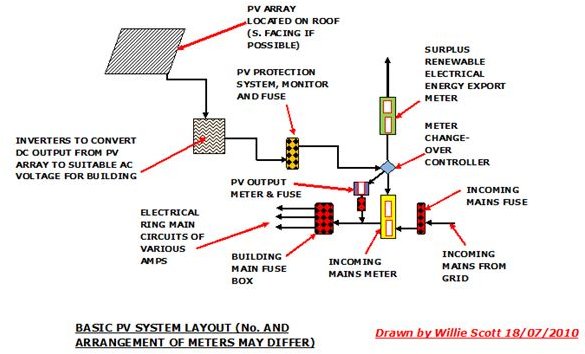Solar Panel Feed In Tariff - US and UK - Adding KW to the Grid and Saving Money for your Home
Introduction to Feed in Tariffs
In an attempt to reduce greenhouse gas emissions from power plants, and meet renewable energy targets European Governments have introduced feed in tariffs (FITs). These are payments made to people who have had renewable energy devices that produce electricity installed on their premises. The most common devices are domestic wind turbines and photo-voltaic cells (PV panels), but there are other devices which could equally be eligible.
The scheme makes payments for every renewable energy kWh of electricity used in the building and any excess being exported to the grid, which qualifies for another payment per kWh.
This is an article on renewable energy and in particular payment made to people who have renewable energy devices installed capable of producing electricity.
It is worth mentioning at this stage that the UK currently gets around 5.5% of electricity from renewable sources and that will need to increase to around 30% to meet the 15% 2020 target for all energy. Domestic renewable energy could add 2% to this total of 5.5% by 2020.
However, we begin this article with an overview of the types of renewable energy devices which qualify for payments under the latest FITs guidelines.
Renewable Devices Qualifying for Feed in Tariffs
Note**:** the devices must be certified by the government body (MSC), be rated under 5MW, installed by an approved contractor, and be operating after 25th July 2009.
Homeowners, tenants, businesses, schools and farms are eligible for FITs payments.
- Solar Electric Photovoltaic Panels (PV)
- Wind Turbines
- Anaerobic Digesters – producing biogas for conversion to electricity
- Small-scale Hydro Power
- Small gas powered combined heat and power (up to and including 2kW)
Reference: Energy Saving Trust UK - Energy Efficiency & Energy Conservation to combat Climate Change
Operation Requirements and Costs for a PV System
From the above list we will examine a PV Panel Array, as fitted to the roof of a standard four-bedroom house in the south of England.
PV panels operate best in bright sunshine, however the still operate under cloudy conditions, albeit at reduced output. Their output is rated in peak power (kWp) as measured in bright sunshine and this rating is used to calculate the amount of panels to meet your house electricity consumption.
The panels are normally fitted to the building’s roof. At present there are many designs which are ergonomic, blending in with existing roof tiles or slates, and there are no planning applications required for fitting PV panels, although listed buildings can sometimes be an exception.
The PV panels produce DC electricity which must be converted to grid AC current using an inverter. Inverters run notoriously hot, some giving off fumes, so make sure they are located in a ventilated area (garage?) There will also be a special electricity meter(s) required to handle power generated, power consumed, and power exported, however the whole of the UK is changing over to “smart meters"’ in the next few years, so this one meter will do all the above operations.
Although feed in tariffs have been widely subscribed to in Europe, the USA are lagging behind. It would appear that the USA government decision makers prefer to rely on previous schemes to reduce fossil fuel use such as tax incentives, subsidies and grants, for users of renewable energy devices. The solar industry in particular has received massive funding for development and grant aid for users.
However, some states such as Florida are implementing a version of FITs, where the local supplier is offering $0.32 per kWh for electricity generated and used by a renewable source, being guaranteed for 20 years.
Vermont has joined Florida, and other states including Michigan, New York, and Wisconsin have indicated a definite interest in FITs.
References
Energy Saving Trust UK - Feed In Tariff (Clean Engergy Cashback) scheme
Renewable Energy World - FIT Coalition Launches North America Campaign
Costs involved in fitting a PV System
PV system Costs for purchase and installation
In most parts of Europe, the cost of fitting a PV system to your house is £7000-£12000; this includes the PV panels, wiring, meters, inverters and LCDs, depending on the size of array required.
As of July 2010 the costs/watt of power generated by PV panels in the USA were $4.18/watt compared to €4.18/watt for Europe.
Therefore disregarding the difference in labor costs, the complete system installed and operating in USA should cost similar to that in Europe of $10,500 - $18,000, depending on the size of rooftop array required.
FITs Payments
Just how much does FITs pay?
FITs can save and earn money in three ways through the in the following cash-back/saving methods;
- For every unit (kWh) of electricity generated by the PV Panels, a payment of at least 41.3 pence will be made.
- Because you are producing your own renewable electricity, which saves around 12 pence/unit, the existing electricity bills will be reduced.
- Any surplus electricity from your PV panels, which you haven’t used can be sold to the grid for 3 pence/unit exported.
Note: for the standard 2kWh rated PV array of 12 PV panels, this could lead to savings and a cash return of £900/year, and this is guaranteed by the British Government for the next 25 years!
